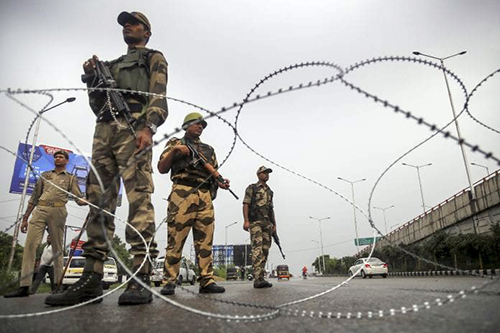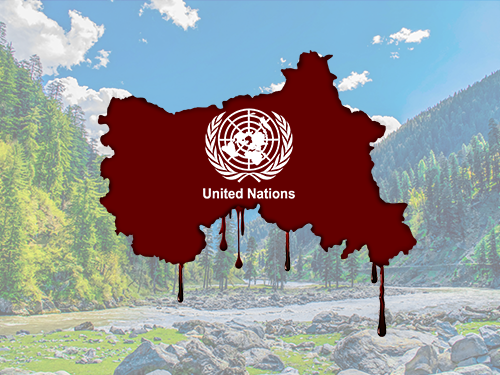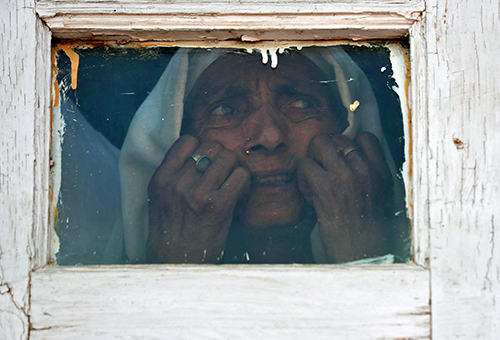Despite lingering hopes for peace between Pakistan and India – the two nuclear-armed neighbours – remain inextricably tied together in a straitjacket with both looking in the opposite direction while crying hoarse at each other. They just cannot unbuckle themselves in their traditionally knotty animosity and are today the world’s only two countries, which remain perennially locked in a confrontational mode. At times, they are not even on speaking terms with each other as is the case now. Both countries need to come out of this self-defeating mode and give peace a real chance. Any purposeful discussion on Pakistan-India relations must begin with a clear understanding of four basic realities:
- Legacy of a troubled relationship
- Complexity of the issues involved
- Centrality of the Kashmir issue
- Cruelty of Geopolitics
As for the historical perspective, we are dealing with the almost 75-year-old legacy of a troubled relationship marked by conflict and confrontation and unresolved disputes that goes back to the dawn of their independence. The complexity of the issues involved is manifest in the deep-rooted mistrust and apprehensions on both sides which will not evaporate simply by blowing out the flames. Pakistan and India will have to go beneath the fire to extinguish it at its source. And at the core of all their problems is the Kashmir issue which has kept their relations perennially bedeviled, perpetuating mutual animosity. Besides being the key unfinished agenda of the partition plan, it is a question involving the inalienable right of self-determination of the Kashmiri people.
While all other issues are amenable to easy solutions, the Kashmir dispute invokes intense feelings among the people of India and Pakistan as well as Kashmir. Scars of partition, legitimate Kashmiri struggle, Siachen dispute, Kargil crisis, a volatile Line of Control and water disputes – all converge in the Kashmir dispute. The cruelty of geopolitics did not end with Pakistan’s breakup in 1971. India still militarily occupies a vast territory, including Kashmir, Siachen, Kargil and water sources that belonged to Pakistan. No wonder, from the very beginning of their independent statehood, the two countries became adversaries and have remained so till now. Indeed, it’s a legacy of conflict rooted in their history.

They have also had a long history of unfruitful peace processes. In the 50s, as a follow-up to the UN Security Council resolutions on Kashmir, UN Special Representative Sir Owen Dixon tried to negotiate a settlement based on his partial plebiscite and partition plan. In the early 60s, Bhutto-Swaran Singh talks were held without any significant headway. After the 1965 war and in the post-1971 period, internal problems kept Pakistan focused domestically. The 1972 Shimla Agreement created its own dynamics which India has always used to assert its own version of bilateralism in its relations with Pakistan. In the 80s, President Ziaul Haq gave a fair chance to the Indian approach of ‘normalisation first,’ but his cricket diplomacy failed to produce results.
In the 90s, the Kashmir resistance added a new dimension to the conflict and brought sharper international focus on this issue, especially in the context of the human rights situation and the enormous cost in human life and limb. During 1990-94, seven rounds of foreign secretary-level talks remained inconclusive. In March 1997, the foreign secretary-level talks in which I represented Pakistan were resumed. When I started negotiations with my Indian counterpart Salman Haider, there was no illusion in our minds. We both expected no miracles. Yet, in June 1997, we did reach an agreement on a peace process familiarly known as Composite Dialogue involving an eight-item agenda and a structured mechanism to resume the long-awaited dialogue process.
When we signed this agreement, we knew that India-Pakistan peace was never meant to be an event. It was going to be a process with a carefully structured framework to address the whole gambit of Pakistan-India issues. The period from 1997 to 1999 no doubt saw significant developments in the peace process in the form of several summit-level meetings between the two countries on the sidelines of the UN annual sessions and other regional and international conferences.
South Asia’s problems are further aggravated by the complex regional configuration with growing Indo-US nexus and India’s resultant strategic ascendancy in the region with an unprecedented influence in Afghanistan and serious nuisance potential against Pakistan’s security interests
These high-level contacts led to the Lahore Summit in February 1999 as a genuine breakthrough in the history of the two countries. The Lahore Declaration signed on February 21, 1999 was a high watermark in Pakistan-India bilateral relations.
But the peace process initiated at Lahore was soon interrupted when the two countries faced the Kargil crisis. Even after Kargil, the region remained under dark war clouds with India and Pakistan standing at the brink of yet another conflict over Kashmir. The tragic events of 9/11 should have served as a catalyst to bring South Asian nations together in the fight against terrorism. We, however, saw terrorism itself becoming an endless issue between Pakistan-India. An intense diplomatic pressure by the United States and other G-8 countries then led to a ceasefire in November 2003, averting what could have been a catastrophic clash between the two nuclear states. The same pressure from influential powers led to resumption of their stalled dialogue in January 2004.
The January 6, 2004 Islamabad Joint Statement became the basis for the resumed India-Pakistan dialogue. But for one reason or another, since 2006, the dialogue process has remained deadlocked. And that’s where we are stuck today. As it got a sympathetic ear in the US and elsewhere in the world on the issue of what it alleged “Pakistan-sponsored terrorism,” India smelled blood thinking that now was the time for a “kill.” It came to realise that while the world was fixated on terrorism, there could be no better opportunity to exploit this global concern. In its view, the time was ripe for it to pressure Pakistan to an extent where it would surrender on Kashmir. Somehow, our ruling hierarchy had no idea what it meant to surrender in Kashmir.
They only helped facilitate this overbearing confidence in Delhi by weaknesses in our own Kashmir-related stratagem in the last decade or so. Meanwhile, encouraged by its “strategic” partnership with the US, India managed to gain unprecedented influence in Afghanistan with serious nuisance potential against Pakistan, which it has been trying to use as part of its state policy to ‘redefine’ the Kashmir issue. Taking advantage of the post-9/11 anti-terror global sentiment, India kept blaming Pakistan for successive train attacks in Mumbai in July 2006 and Samjhota Express in February 2007, and then for the Mumbai attacks in November 2008. No wonder, since then, the Pakistan-India dialogue process has remained deadlocked.
While all other issues are amenable to easy solutions, the Kashmir dispute invokes intense feelings among the people of India and Pakistan as well as Kashmir
South Asia’s problems are further aggravated by the complex regional configuration with growing Indo-US nexus and India’s resultant strategic ascendancy in the region with an unprecedented influence in Afghanistan and serious nuisance potential against Pakistan’s security interests. This situation is not without serious implications for the delicate balance of power and stability in this region and is already undermining the peace process and prospects of conflict resolution and nuclear and conventional stabilization between India and Pakistan. But Washington had its own priorities for this region as part of its China-driven larger Asian agenda and its ongoing Central Asia-focused great game in pursuit of its worldwide political and economic power.
India, once a founder of the non-aligned movement, is today one of the most aligned countries of the world. It has allowed itself to become a tractable wheel in America’s larger Asian power play. The US has been openly encouraging India to assume a larger role in regional affairs and assert its leadership in Asia. For Washington, that will positively shape the future of the Asia-Pacific. This aspect of America’s Asian policy, it seems, is being played out more aggressively in the backdrop of China’s increasingly firm assertion of South China Sea, Tibet and Taiwan as its core interests. India, because of its size and overbearing centrality, has also sought to remain alone as an exclusive power asserting itself as a primus inter pares (first among equals) in the region.
It is this anomalous geopolitical situation that has also kept SAARC captive to its geopolitics. Already, India’s size and clout generate many problems in the region including the fear of domination among its smaller neighbours and a host of border conflicts and water disputes with most of them. Conflict is the last thing this region needs. As the largest country in the region, the onus lies with India to inspire confidence among its neighbours. With our lingering fears and suspicion that India never reconciled to the subcontinent partition, we in Pakistan have been living since independence in the shadow of Indian hostility and belligerence. This fear was not exaggerated when Pakistan saw Sikkim, Goa, Hyderabad, Junagadh and Kashmir falling to Indian avarice.
This fear is not exaggerated today as Pakistan faces India’s continued cold-blooded realpolitik. Over the years, the Kashmir dispute has turned into a global issue of peace and security. It has a magnified manifold becoming today a veritable nuclear flash point. On the frozen landscape of the Siachen as along the ever-volatile line of control in Kashmir, both countries remain locked in an eye-ball-to-eye-ball confrontation. What we in Pakistan now understand is that weakness always begets indignity. Only a strong and stable Pakistan can withstand India’s declared belligerence. This is what Pakistan demonstrated in its befitting response on February 27, 2019 to India’s naked act of aggression in its territory. We had a different kind of leadership in Pakistan at that time.
Through its illegal abrogation of Article 370/35-A on August 5, 2019, India made another ruthless attempt to change the status of Jammu and Kashmir in violation of the UN Security Council resolutions. The world must know that there is but one fair, just, legal and moral solution to Kashmir which was provided by the United Nations, and which both India and Pakistan mutually accepted in UN Security Council resolutions. On other issues, we cannot ignore India’s illegality in Siachen and its ongoing water terrorism in Occupied Kashmir by building dams and reservoirs on Pakistani rivers in violation of the Indus Waters Treaty. The government must not rush into one-sided trade that brings a negative effect on our industry. Trade requires a level-playing field.

Given its turbulent political history, this region needs stable peace, not confrontation. And peace in South Asia will become a reality only if India returns to the negotiating table in good faith and with sincerity of purpose. Perpetuation of hegemony will not serve the cause of peace. The risk of an India-Pakistan conflict erupting into a nuclear apocalypse is fraught with a disaster of an unimaginable magnitude and must be averted at all cost. There can be no compromise on Kashmir as long as India continues to deny the right of self-determination to the Kashmiris. Until then, we must continue to extend full political, diplomatic and moral support to the Kashmir cause and keep upholding the Kashmiris right of self-determination in every international forum.
The truth is that Kashmir is neither about cross-border infiltration nor terrorism; it is about the denial of an indigenous people’s right to freedom and dignity. It is about the inalienable right of the Kashmiri people pledged to them by the international community through numerous UN Security Council resolutions. No matter what the Indians claim, there is but one fair, just and legal solution to Kashmir as provided in those resolutions, and which both India and Pakistan had mutually accepted. The wishes of the Kashmiri people must be ascertained impartially, in conditions of freedom from military coercion. This is the crux of the Kashmir issue.
Way forward
There can be no two opinions on the need for durable peace between India and Pakistan – the only two nuclear-armed neighbours with a legacy of outstanding disputes and a history of conflicts. India-Pakistan problems are real and will not disappear or workout on their own. The only way forward is the resumption of the ‘composite dialogue’ under any nomenclature with sincerity of purpose. To make this process sustainable, Pakistan and India will have to develop a clearer framework of principles on the basis of which to organise their future relations while exploring peaceful solutions to their problems.
This would require purposeful contact between the political leadership of the two countries. India must reconsider its present ‘no-talk’ approach. Disputes can only be resolved through dialogue and engagement. I remember that as lately as the late 1990s, India and Pakistan were showing “flexibility of approach” in their quest for a peaceful settlement of all outstanding bilateral issues, including the Jammu and Kashmir dispute. They knew the people in both countries had suffered for too long as a result of continuing tensions and conflicts and would welcome any new innovative approach that facilitates a practical and achievable solution of the Kashmir issue.
Obviously, they knew that this would require them to move beyond their respective stated positions and to find a “practical and achievable” solution of the Kashmir issue which would not be based on legitimisation of the LoC. One thing is clear: Beyond UN resolutions, there is no compact formula or tailor-made solution available for addressing the Kashmir issue. But if India and Pakistan can join together with the Kashmiri people, they could explore mutually acceptable common ground for a genuine Kashmir solution beyond the status quo. Surely, there will be no quick-fixes and perhaps a long-drawn-out process with freshness of political approach would be inevitable.
What we need is an ‘uninterrupted and uninterruptible’ dialogue with firm commitment to a result-focused engagement. And peace in South Asia will remain elusive as long as Kashmir remains under Indian occupation. The international community must facilitate this solution. By now, what should be clear to both sides is that there will be no military solution to their problems.
For this purpose, regular agenda-specific and result-oriented engagement between the political leadership of the two countries would be required. There has to be visible progress at least in some areas. Steady improvement of relations requires mutual confidence-building measures. In the ultimate analysis, the success of this process would depend entirely on the freshness of political approach that leadership on both sides would be ready to bring in with sincerity of purpose. To negotiate an honourable peace with India, our own country must first be at peace with itself. Indeed, weakness begets indignity. Our foremost challenge is to overcome our domestic weaknesses.

It is time we restored our dignity by putting our own house in order. Domestic consolidation with special focus on security and economic situation should be our foremost priority. We must free the country of its current weaknesses and ignominies. Only then, can we sit at the negotiating table with a position of strength. Meanwhile, we also need to change world’s perception of our country, which has many reasons and assets — other than terrorism and violence — to be recognised as a responsible member of the international community. We must free ourselves of the forces of obscurantism, extremism, violence, militancy and intolerance.
In recent years, we have become weak and crippled domestically because of leadership miscarriages and governance failures. India has been taking advantage of our weaknesses. Domestic consolidation with special focus on security and economic situation must be our priority. It is also time for the voices of reason and responsibility in the United States, China, Russia, Europe and the Arab and Muslim world to caution against militarism and demand strict adherence by all states, large and small, to UN Charters central principle prohibiting the use or threat of use of force in international relations.

